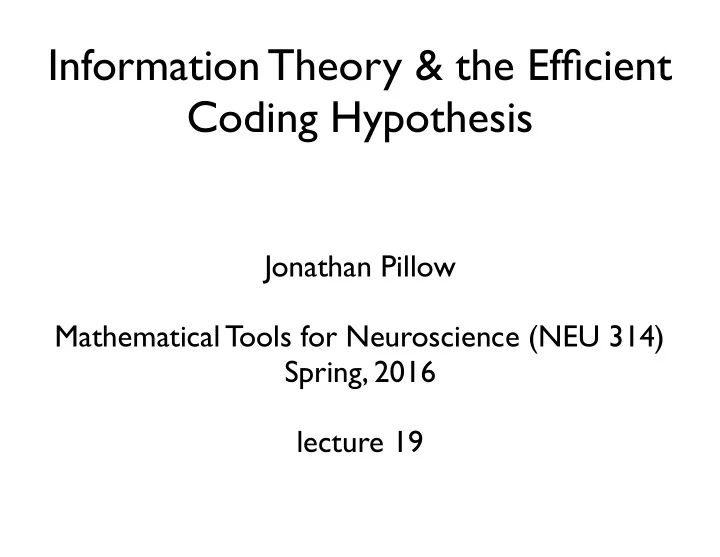

Information Theory & the Efficient Coding Hypothesis Jonathan Pillow Mathematical Tools for Neuroscience (NEU 314) Spring, 2016 lecture 19
Information Theory A mathematical theory of communication , Claude Shannon 1948 • Entropy • Conditional Entropy • Mutual Information • Data Processing Inequality • Efficient Coding Hypothesis (Barlow 1961)
Entropy averaged “surprise” over p(x) of x • average “surprise” of viewing a sample from p(x) • number of “yes/no” questions needed to identify x (on average) for distribution on K bins, • maximum entropy = log K (achieved by uniform dist) • minimum entropy = 0 (achieved by all probability in 1 bin)
Entropy
aside: log-likelihood and entropy model: entropy H: How would we compute a Monte Carlo estimate of this? draw samples: for i = 1,…,N compute average: log-likelihood • Neg Log likelihood = Monte Carlo estimate for entropy! • maximizing likelihood ⇒ minimizing entropy of P(x| θ )
Conditional Entropy � � H ( x | y ) = p ( y ) p ( x | y ) log p ( x | y ) − y x � averaged entropy of x given over p(y) some fixed value of y
Conditional Entropy � � H ( x | y ) = p ( y ) p ( x | y ) log p ( x | y ) − y x � averaged entropy of x given � � over p(y) some fixed value of y � = p ( x, y ) log p ( x | y ) − x,y if “On average, how uncertain are you about x if you know y ?”
Mutual Information total entropy in X minus conditional entropy of X given Y total entropy in Y minus conditional entropy of Y given X sum of entropies minus joint entropy “How much does X tell me about Y (or vice versa)?” “How much is your uncertainty about X reduced from knowing Y?”
Venn diagram of entropy and information
Data Processing Inequality Suppose form a Markov chain, that is Then necessarily: • in other words, we can only lose information during processing
Barlow 1961 Efficient Coding Hypothesis: Atick & Redlich 1990 • goal of nervous system: maximize information about environment (one of the core “big ideas” in theoretical neuroscience) mutual information redundancy: channel capacity
Barlow 1961 Efficient Coding Hypothesis: Atick & Redlich 1990 • goal of nervous system: maximize information about environment (one of the core “big ideas” in theoretical neuroscience) mutual information redundancy: channel capacity mutual information: • avg # yes/no questions you can answer about x given y (“bits”) response entropy “noise” entropy channel capacity: • upper bound on mutual information • determined by physical properties of encoder
Barlow 1961 Barlow’s original version: Atick & Redlich 1990 mutual information redundancy: mutual information: if responses are noiseless response entropy “noise” entropy
Barlow 1961 Barlow’s original version: Atick & Redlich 1990 response entropy redundancy: mutual information: noiseless system response entropy “noise” entropy brain should maximize response entropy • use full dynamic range • decorrelate (“reduce redundancy”) • mega impact: huge number of theory and experimental papers focused on decorrelation / information-maximizing codes in the brain
basic intuition natural image nearby pixels exhibit strong dependencies neural representation pixels desired 256 100 neural response i+1 encoding pixel i+1 128 50 0 0 0 128 256 0 50 100 neural response i pixel i
Example: single neuron encoding stimuli from a distribution P(x) stimulus prior noiseless, discrete (with constraint on range of y values) encoding
Application Example: single neuron encoding stimuli from a distribution P(x) stimulus prior noiseless, discrete (with constraint on range of y values) encoding 0.5 Gaussian prior p(x) 0.25 0 response distribution −3 0 3 x 20 output level y p(y) 10 cdf 0 0 0 10 20 −3 0 3 output level y x
Laughlin 1981: blowfly light response • first major validation of Barlow’s theory cdf of light level response data
summary • entropy • negative log-likelihood / N • conditional entropy • mutual information • data processing inequality • efficient coding hypothesis (Barlow) - neurons should “maximize their dynamic range” - multiple neurons: marginally independent responses • direct method for estimating mutual information from data
Recommend
More recommend